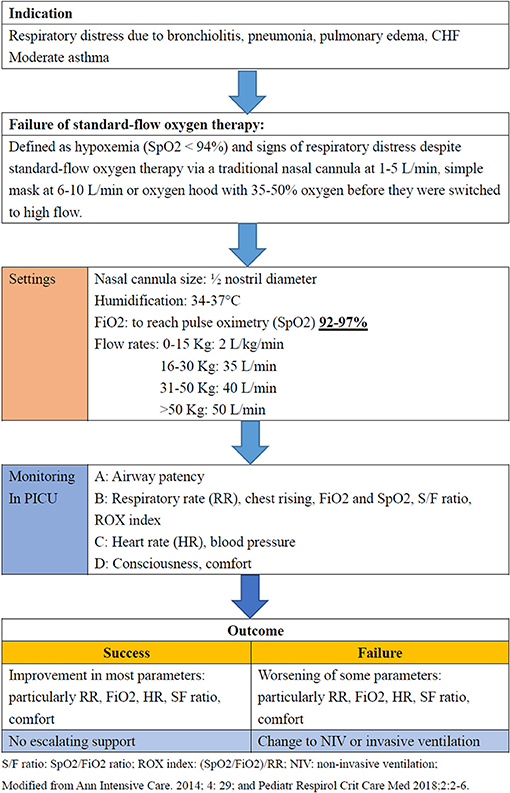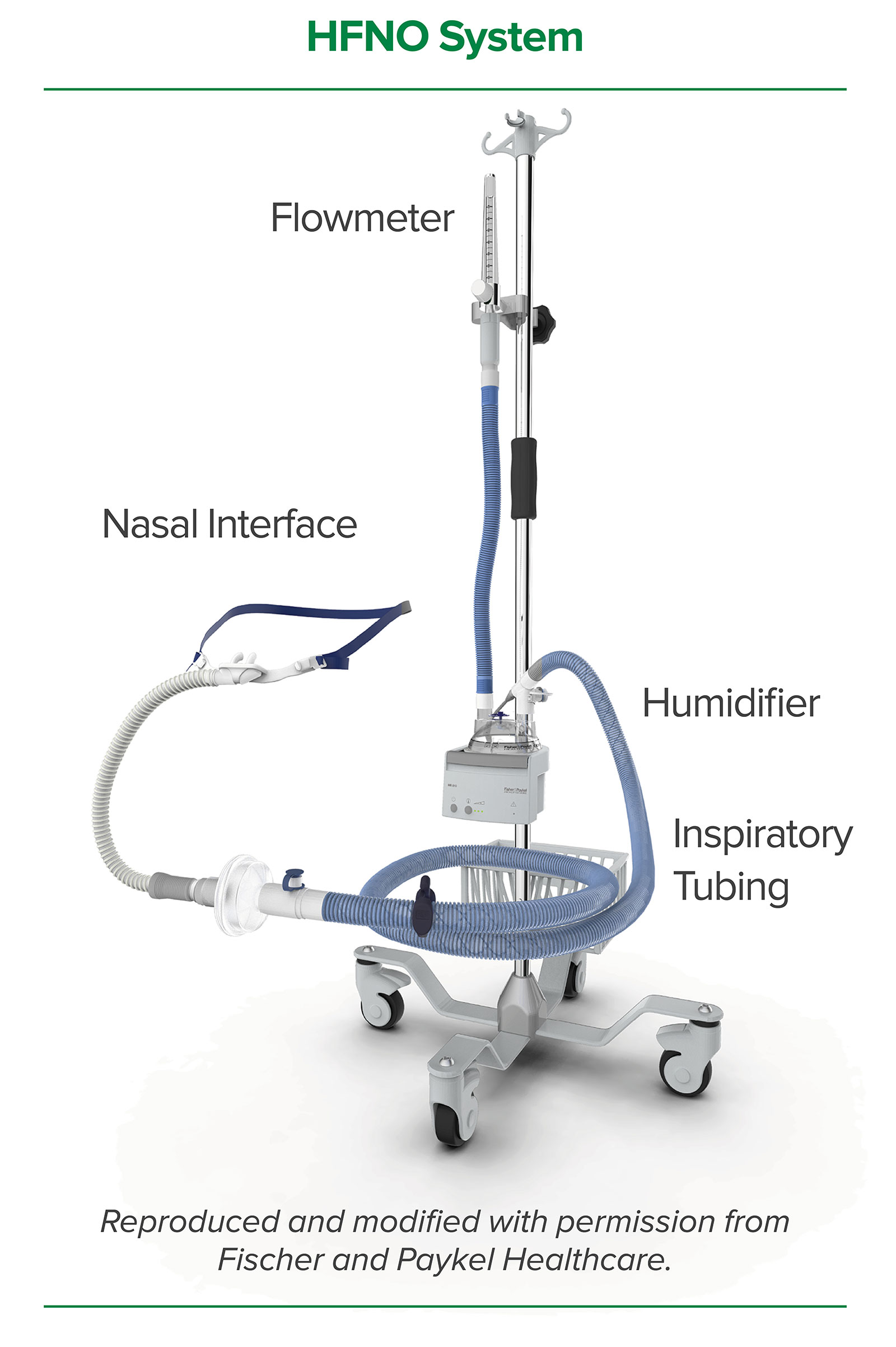high flow nasal cannula flow rate range
High flow nasal cannula HFNC. The action mechanism of HFNC includes a decrease in nasopharyngeal resistance washout of dead space reduction in inflow of ambient.
More on management of ARDS here.

. 2 Lkgminute for the first 12kg 05Lkgminute for each kg thereafter max flow 50 Lmin. Respiratory support intubated patients. Since their initial development reliability has been improved and POCs now produce between one and six liters per minute LPM of oxygen depending on the breathing rate of the patient.
Dexamethasone treatment improves mortality for the. HFHNC has been shown in a number of studies to. When used appropriately high flow nasal cannula HFNC may allow CARDS patients to avoid intubation and does not increase risk for disease transmission.
Once prescribed flow rate is reached assess requirement for supplemental oxygen. Butterfly Valve applicable for low-pressure loss and Ball Valve could be applied for the flow of high-pressure liquids and gases with minimal pressure drop in energy plants. Nasal High Flow NHF via the Airvo 1 2 circuit is able to deliver a user set fixed fraction of inspired oxygen at high flow rates.
When compared with the 900PT501 Airvo tube in internal Fisher Paykel Healthcare testing. High flow device delivering up to 10 LPM. The other advantage of delivering high flow oxygen through a nasal cannula is to continuously flush out the upper airway dead space by better CO2 clearance.
30lpm flow recommended for ward based care Humidification. We would like to show you a description here but the site wont allow us. Respiratory rate and pattern are stable Can deliver high FiO2but actual amount will vary from breath to breath Examples include nasal cannulasimple face.
Minimal replacement parts and built-in casters for easy transport. The latest models of intermittent flow only products weighed in the range of from 28 to 99 pounds 13 to 45 kg and continuous flow CF units were between 10 and 20 pounds 45 to 90 kg. DC Mobile Power DC Power Cord Included.
When you use a flow rate of 1. HFNC provides good patient comfort through heated and humidified gas. As mentioned room air is 21 percent oxygen so you are breathing a FiO2 of 21 percent without supplemental oxygen.
During invasive mechanical ventilation low tidal volume ventilation and positive end expiratory pressure PEEP titration to optimize oxygenation are recommended. High-flow nasal cannula HFNC is a relatively safe and effective noninvasive ventilation method that was recently accepted as a treatment option for acute respiratory support before endotracheal intubation or invasive ventilation. Oxygen delivered at higher rates using a traditional nasal cannula can dry out sinus passages and lead to nosebleeds.
A standard nasal cannula delivers between one-half liter and 6 liters of oxygen per minute. Take into account any extras that ship with. Attempt recruitment with high PEEP or APRV.
Easy-to-use control panel with LED indicators and audible alarms. HFHNC can be delivered with flow rates in pediatrics up to 2 Lkgmin. 1 Review Add Your Review.
Oxygen purity indicator. 87 of 100. This reduces work of breathing for the patient and improves oxygenation.
High flow is usually defined as flow rate 2 Lmin the flow rate depending on the type of cannula used but ranging from 4 to 70 Lmin. From 21 room air to 10. 93 less condensate AirSpiral heated breathing tube with integrated dual-spiral heated wires and temperature sensor.
Multimodal analgesia eg scheduled acetaminophen pain-dose ketamine infusion PRN opioids. We are a prime solenoid valve and other control system valve manufacturer as well as a supplier in. The gas in HFHNC is heated to body temperature and near completely humidified with water vapor.
Delivery Systems Low-flow oxygen delivery systems include nasal cannula simple masks reservoir masks partial rebreather and nonrebreather. For several other applications solenoid valves are also used especially Gas Solenoid Valve. High-flow nasal cannula therapy delivers humidified and heated oxygen and can flow at a rate of up to 60 liters per minute.
High flow humidified nasal cannula HFHNC oxygen can provide a higher FiO 2 and is more easily tolerated as compared with standard nasal cannula. High-flow systems are capable of delivering at least 40 liters per minute. Nasal Cannula Variety Pack with 12 Cannulas.
Expect higher-quality and advanced features at the higher price point including a higher flow rate improved concentration percentages and even a choice between pulse dose and continuous flow delivery. Nasal Cannula Flow Rate and FiO2 Although certain factors such as how fast you breathe and the size of your breaths slightly impact the FiO2 theres a pretty good guideline to follow when determining your FiO2. High-flow systems deliver FiO 2 at flow rates that meet or exceed the patients peak respiratory requirements.
21 50 recommendation for ward based care Flow rates. AC Wall Power Universal 100-240 VAC 5060 Hz 20 A. Nidek Mark 5 Nuvo Lite Oxygen Concentrator.
No separate temperature probes or adapters required. High-flow nasal cannula may be used for patients unable to tolerate CPAPBiPAP or to provide breaks. DC Power Input 115.
Alarms Low Oxygen Purity No Breath High Breath Rate No Flow Low Battery Depleted Battery Wrong Battery System Technical Fault. In a retrospective and descriptive study 200 patients who underwent cardiac surgery were randomly included and screened for initiation of. We aimed to investigate the risk factors and reason for initiation of high-flow nasal cannula HFNC its benefit on re-intubation rate mortality and length of stay LOS in the postoperative cardiac surgery patient in the ICU.
In addition high flow oxygen therapy ensures high FiO2. Supplemental Oxygen High Flow Systems generally utilize corrugated tubing Indicated in patients with variable respiratory rate and pattern to provide appropriate FiO2 to meet a patients respiratory demand. Flow rate for HFNP Therapy is the same for all patients regardless of medical condition.
They start at around 300 and run up to 1000 or more with the average in the 350 to 500 range. 31C - 37C Benefits of NHF High flow enables maintenance of FiO2 despite increase in work. Continuous flow up to.
Start the high flow nasal cannula system in room air ie. Power Consumption 120-150 Watts. Debate is ongoing as to whether HFNC may reduce the use of less tolerated and more invasive ventilator supports such as continuous positive airway pressure CPAP and mechanical.
Add and titrate oxygen separately from flow rate.

High Flow Nasal Cannula Oxygenation Utilization In Respiratory Failure European Journal Of Internal Medicine

Characteristics And Outcome Of High Flow Nasal Cannula Episodes Download Table

A Hospital Stay Of The High Flow Nasal Cannula Oxygen Therapy Hfno Download Scientific Diagram

Study Flow Chart And Pathway Detailed Study Design And Procedures Download Scientific Diagram

How Does High Flow Nasal Cannula Hfnc Work Medmastery

Frontiers High Flow Nasal Cannula Therapy In Children With Acute Respiratory Distress With Hypoxia In A Pediatric Intensive Care Unit A Single Center Experience Pediatrics

Initial Or Starting Flows Of High Flow Nasal Cannula In A Pediatric Download Table

Safe Use Of High Flow Nasal Oxygen Hfno With Special Reference To Difficult Airway Management And Fire Risk Anesthesia Patient Safety Foundation

